Did you know that the Lady Amherst Pheasant, with its stunning colors and distinctive appearance, is not native to the United States? This beautiful bird can be found in private collections and wildlife parks, but its presence in the UK has become increasingly rare. In this comprehensive guide, we will explore everything you need to know about the Lady Amherst Pheasant, from its habitat and diet to its breeding behavior and conservation status.
Appearance & Identification
The Lady Amherst Pheasant is known for its unmistakable appearance. The male has a black and white ground color with a long, crisscrossed tail. Its head is adorned with a red crest and a green crown, and its back and throat area are reflective, appearing iridescent green and blue. The female is less colorful, with a rufous-brown color and strong black barring. Lady Amherst Pheasants are significantly larger in size, with males measuring 51-68 inches in length and females measuring 26-27 inches. The wingspan for both sexes is usually between 27.5 and 33 inches.
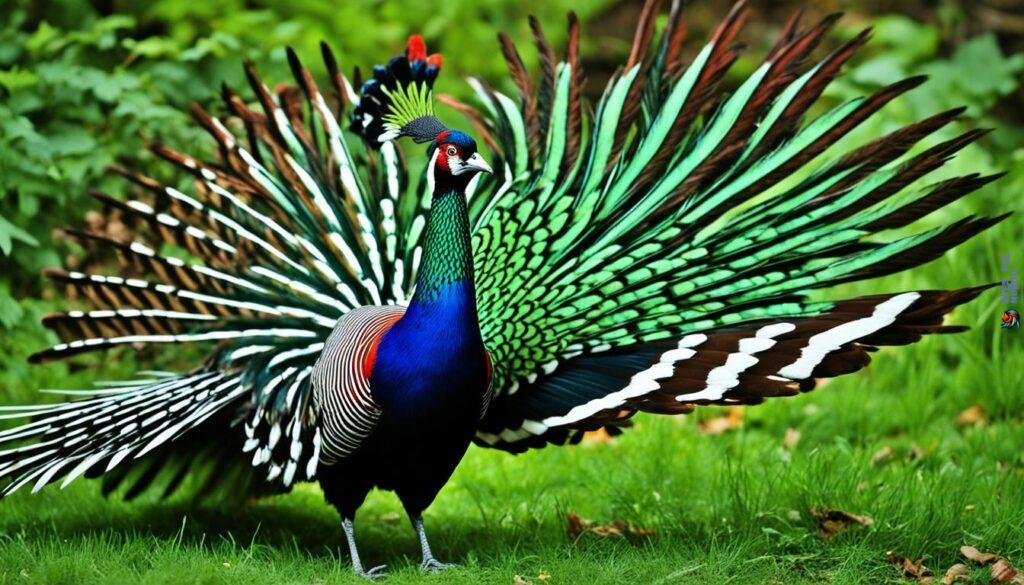
Habitat & Distribution
Lady Amherst Pheasants are primarily found in fairly high altitude, wooded habitats with bamboo and thick scrub. They inhabit a small region of Southeast Asia, including parts of Tibet, China, and Myanmar. The dense vegetation provides them with ample cover and protection.
In their native range, Lady Amherst Pheasants can be found in areas with forested hills and mountains, often near water sources such as rivers and streams. The presence of bamboo is particularly important to their habitat as it serves as a significant food source and offers shelter.
Lady Amherst Pheasants have also been introduced to the United Kingdom, where they have established a feral population since the 19th century. However, the feral population in the UK has faced challenges and has dwindled in recent years.
Overall, understanding the habitat requirements and distribution of these beautiful birds is essential for their conservation and management.
| Habitat | Distribution |
|---|---|
| Fairly high altitude | Southeast Asia: Tibet, China, Myanmar |
| Wooded habitats | United Kingdom (feral population) |
| Bamboo and thick scrub |
Diet
Lady Amherst Pheasants have a diverse diet that includes both animal and plant matter. They are considered omnivorous and feed on various insects and invertebrates, which form a significant part of their diet. Additionally, they consume plant material such as young bamboo shoots, fern fronds, seeds, and roots.
Interestingly, baby Lady Amherst Pheasants are precocial, meaning they are independent and capable of foraging for their own food shortly after hatching. However, their mother plays a vital role in guiding them to good food sources. As they grow, they start to eat various wild fruits as well.
Lady Amherst Pheasants have a well-rounded diet that provides them with the necessary nutrients for their growth and survival.
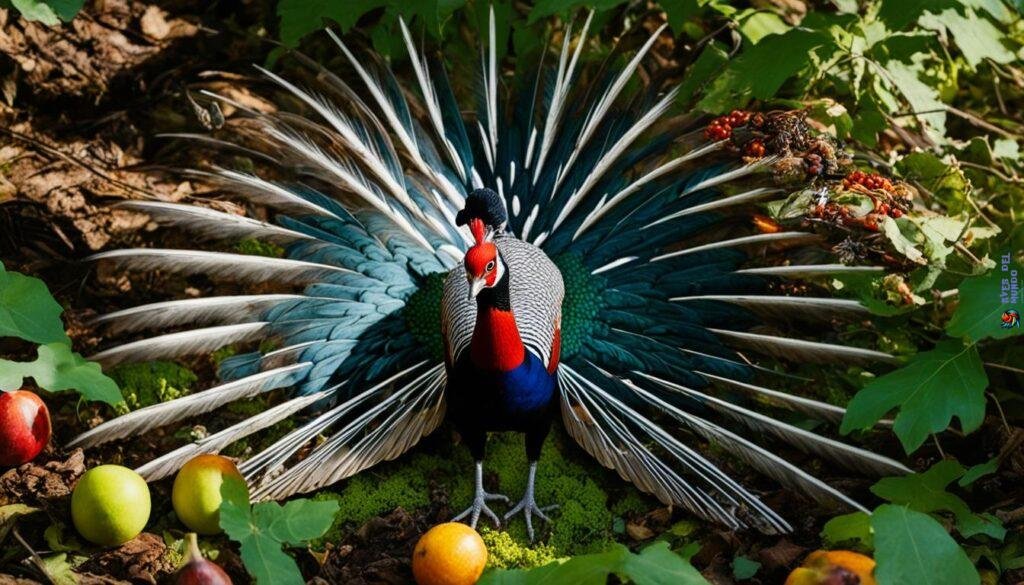
| Food | Description |
|---|---|
| Insects and Invertebrates | Lady Amherst Pheasants feed on a variety of insects and invertebrates, including beetles, grasshoppers, worms, and small crustaceans. |
| Plant Material | They consume young bamboo shoots, fern fronds, seeds, and roots as part of their plant-based diet. |
| Wild Fruits | As they grow, Lady Amherst Pheasants incorporate various wild fruits into their diet. |
Calls & Sounds
The male Lady Amherst Pheasant is known for its vocal nature, particularly during the early mornings. It produces loud territorial calls that resonate through its habitat. The calls are often described as «hirk hik ik» or «cheek er check.» These distinct sounds serve as a means of communication and establishing dominance among males.
The females, although less vocal, also produce sounds of their own. They tend to emit softer clucking sounds and high-pitched peeps, which likely serve as communication signals within the social hierarchy of the species.
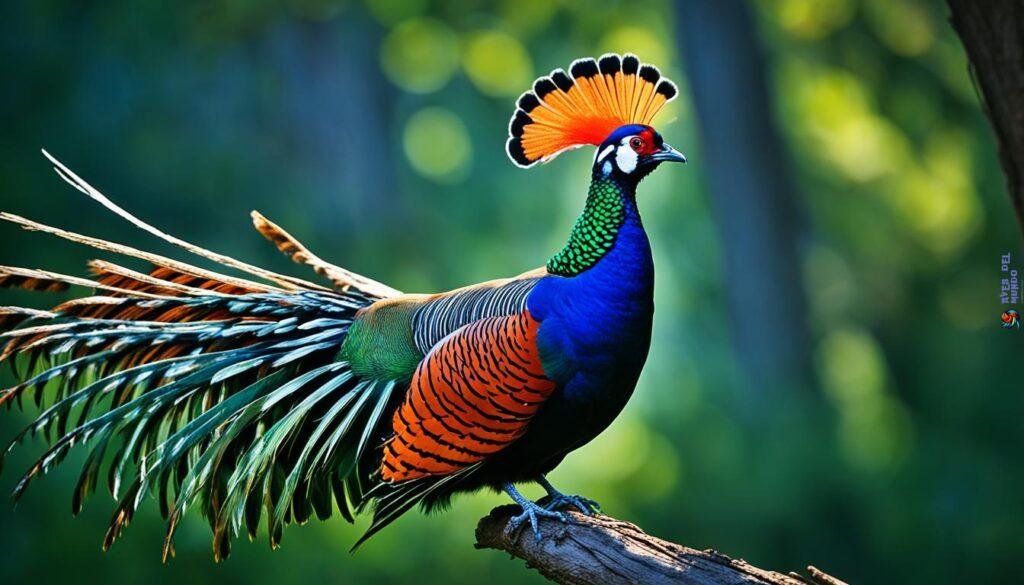
Lifespan & Predation
Lady Amherst Pheasants have an average lifespan of 6 to 10 years in the wild, although captive birds can live longer. They are known to face predation from various mammalian, bird, and reptile predators in their native habitat. Additionally, humans hunt Lady Amherst Pheasants for food, and their eggs may be preyed upon by other bird species. In the UK, feral Lady Amherst Pheasants face a significant predator in the form of foxes.
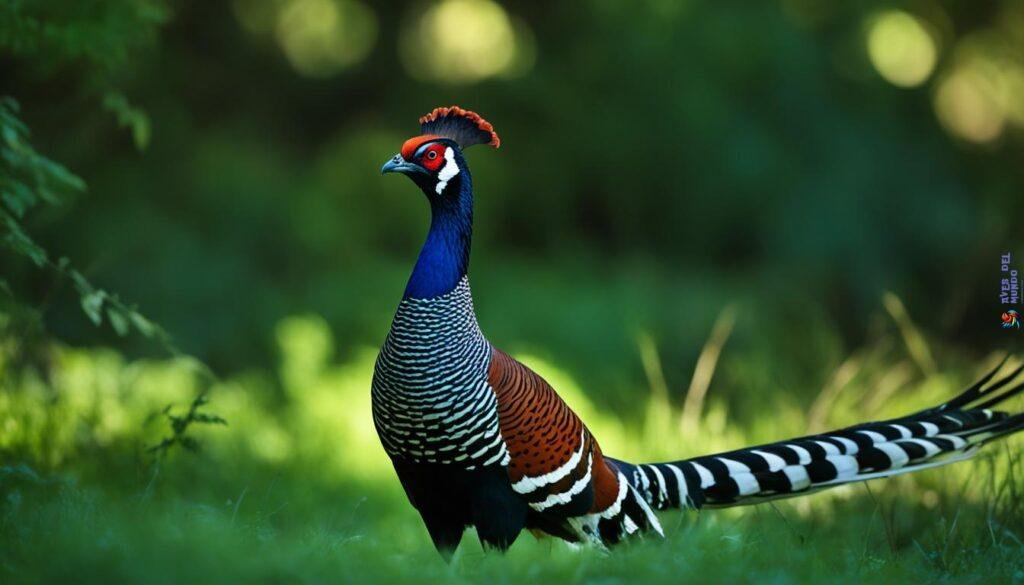
«Lady Amherst Pheasants have developed various adaptations to avoid predation. Their vibrant colors help them blend into their surroundings, making it challenging for predators to detect them. Additionally, their ability to fly swiftly and their agile movements enable them to escape from potential threats.»
Breeding
Lady Amherst Pheasants are known for their unique breeding behaviors and nesting habits. Understanding their breeding cycle and nest construction is crucial in ensuring successful reproduction.
Nest Construction
Lady Amherst Pheasants are ground-nesting birds, meaning they build their nests on the forest floor under suitable cover such as brush or low branches. The female pheasant constructs a shallow nest made of twigs, leaves, and other plant materials, lining it with soft leaves to provide a comfortable and safe environment for the eggs.
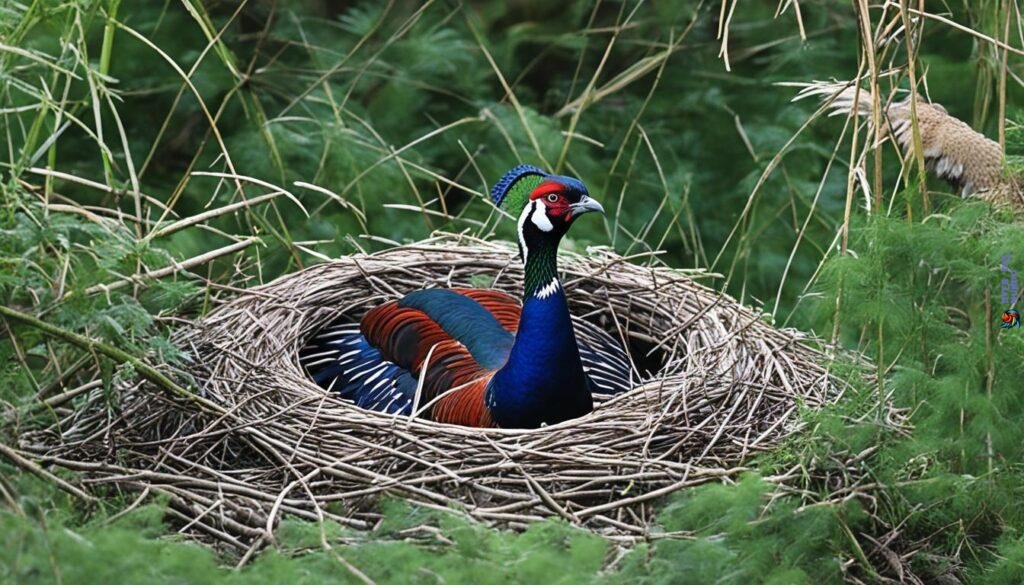
Egg Laying
The female pheasant typically lays a clutch of 6-12 eggs in her nest. These eggs are off-white to buff-colored and speckled, providing excellent camouflage against their natural surroundings. The female incubates the eggs and ensures their proper temperature and humidity until they hatch.
Egg Incubation
The incubation period for Lady Amherst Pheasant eggs is approximately 24 days. During this time, the female remains dedicated to keeping the eggs warm and protected. She diligently turns the eggs and adjusts their position to provide uniform heat distribution, ensuring the development of healthy embryos.
Mating Behavior
The breeding season for Lady Amherst Pheasants occurs during spring. The male pheasants, known for their vibrant plumage, engage in elaborate courtship displays to attract females. The male is polygynous, meaning he mates with multiple females during the breeding season.
| Aspect | Details |
|---|---|
| Reproduction Type | Sexual |
| Clutch Size | 6-12 eggs |
| Egg Color | Off-white to buff with speckles |
| Egg Incubation Period | Approximately 24 days |
| Mating Behavior | Male is polygynous |
Migration
Lady Amherst Pheasants do not undertake long-distance migrations, but they are known to exhibit seasonal movements within their habitat. As altitudinal migrants, they adjust their location based on the seasons and weather conditions. During more favorable seasons, they move to higher slopes to find suitable nesting and foraging areas. When winter arrives, they descend to lower altitudes in search of milder climates and better availability of food resources. Additionally, they may also move to lower altitudes during periods of poor weather, seeking shelter and protection.
Seasonal movements
Lady Amherst Pheasants demonstrate seasonal movements within their altitudinal range. They prefer higher slopes during more favorable seasons and lower altitudes during the winter and adverse weather conditions.
Migratory patterns
Their migration pattern is influenced by the availability of food, nesting habitats, and suitable climate conditions. Lady Amherst Pheasants exhibit a natural instinct to adapt their movements to ensure their survival and reproductive success.
| Migration Behavior | Key Factors |
|---|---|
| Altitudinal migration | Seasonal and weather-dependent movements to different altitudes |
| Food availability | Movement to areas with abundant food resources |
| Nesting habitats | Selection of suitable nesting areas based on altitude and vegetation |
| Climate conditions | Seeking shelter and protection during periods of inclement weather |
Lady Amherst Pheasants have evolved and adapted their migration patterns to optimize their chances of survival amidst changing environmental conditions. Their ability to find food, suitable nesting sites, and escape harsh weather contributes to their resilience in their native habitats.
Behavior
Lady Amherst Pheasants are known for their behavior, which can sometimes be aggressive, especially towards each other. They engage in physical combat, using their sharp claws and beaks to establish dominance and defend their territory. This aggression is more commonly observed among males, who compete for mates and establish hierarchies within their social groups. The fights can be intense, with rapid pecking, flapping wings, and clawing at each other.
Despite their aggressive nature towards their own kind, Lady Amherst Pheasants have been reported to mix well with other species in captivity. They can coexist peacefully in aviaries or enclosures with suitable space and resources. However, it’s important to note that some males may still display territorial behavior towards other bird species, especially if they perceive them as a threat.
«Lady Amherst Pheasants can be quite territorial, especially during the breeding season. It’s fascinating to witness their elaborate displays and fierce battles for dominance.»
– Bird enthusiast and wildlife photographer, Sarah Thompson
Social Hierarchy
Within a group of Lady Amherst Pheasants, a social hierarchy is established, with dominant individuals at the top and subordinate individuals at the bottom. Dominance is usually determined through aggressive displays and physical confrontations. The dominant male often has exclusive access to mating opportunities and defends his territory from other males.
Parental Care
When it comes to parenting, Lady Amherst Pheasants exhibit little to no parental care. Once the female lays her eggs, she abandons the nest and leaves the incubation and rearing responsibilities to the male. The male takes on the role of incubating the eggs and caring for the chicks when they hatch. He fiercely guards the nest and chicks, providing them with protection from predators and teaching them essential survival skills.
Foraging Behavior
Lady Amherst Pheasants are primarily ground foragers, meaning they search for food on the forest floor. They have a diverse diet that includes a combination of insects, small invertebrates, seeds, fruits, and plant matter. These birds use their sharp beaks to peck and dig into the soil to uncover hidden prey. They are also capable climbers, adept at perching on vegetation to access fruits and seeds.
| Behavioral Traits | Description |
|---|---|
| Aggression | Lady Amherst Pheasants can be aggressive towards each other, engaging in physical combat using their claws and beaks. |
| Social Hierarchy | A dominance hierarchy is established within the group, with dominant males having exclusive mating rights. |
| Parental Care | Males take on the role of incubating eggs and caring for chicks, providing protection and teaching survival skills. |
| Foraging Behavior | Lady Amherst Pheasants are ground foragers, searching for a variety of insects, seeds, and plant matter. |
The aggressive behavior of Lady Amherst Pheasants serves important functions in their natural habitat. It helps establish territories, ensures access to resources, and contributes to the survival and reproductive success of individuals. Despite their combative nature, these pheasants are fascinating creatures worth observing and appreciating for their stunning displays and intricate social dynamics.
Conservation Status
Lady Amherst Pheasants, known for their stunning appearance, are not considered endangered. In fact, their conservation status has improved from Near Threatened to Least Concern according to the International Union for Conservation of Nature (IUCN). This positive change is undoubtedly a result of conservation efforts. These beautiful birds are now classified as a Class II protected species in China, a crucial step towards their preservation.
However, it is important to note that the feral population of Lady Amherst Pheasants in the United Kingdom has become increasingly rare. This decline is a cause for concern and emphasizes the need for continued conservation efforts to protect and sustain their dwindling numbers in this region.
Conservation initiatives play a vital role in safeguarding the future of Lady Amherst Pheasants. By actively supporting conservation organizations and raising awareness about the importance of preserving their habitat, we can contribute to the long-term survival and well-being of these magnificent birds.



